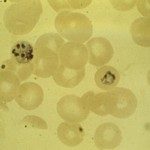Lien vers Pubmed [PMID] – 7623850
Mol Cell Biol 1995 Aug; 15(8): 4585-96
The mouse myosin light-chain 1A (MLC1A) gene, expressed in the atria of the adult heart, is one of the first muscle genes to be activated when skeletal as well as cardiac muscles form in the embryo. It is also transcribed in skeletal muscle cell lines at the onset of differentiation. Transient transfection assays of mouse skeletal muscle cell lines with DNA constructs containing MLC1A promoter fragments fused to the chloramphenicol acetyltransferase (CAT) gene show that the first 630 bp of the promoter is sufficient to direct expression of the reporter gene during myotube formation. Two E boxes located at bp -76 and -519 are necessary for this regulation. MyoD and myogenin proteins bind to them as heterodimers with E12 protein and, moreover, transactivate them in cotransfection experiments with the MLC1A promoter in nonmuscle cells. Interestingly, the effect of mutating each E box is less striking in primary cultures than in the C2 or Sol8 muscle cell line. A DNA fragment from bp -36 to -597 confers tissue- and stage-specific activity to the herpes simplex virus thymidine kinase promoter in both orientations, showing that the skeletal muscle-specific regulation of the MLC1A gene is under the control of a muscle-specific enhancer which extends into the proximal promoter region. At bp -89 is a diverged CArG box, CC(A/T)6AG, which binds the serum response factor (SRF) in myotube nuclear extracts, as does the wild-type sequence, CC(A/T)6GG. Both types of CArG box also bind a novel myotube-enriched complex which has contact points with the AT-rich part of the CArG box and adjacent 3′ nucleotides. Mutations within the CArG box distinguish between the binding of this complex and binding of SRF; only SRF binding is directly involved in the specific regulation of the MLC1A gene in skeletal muscle cell lines.

